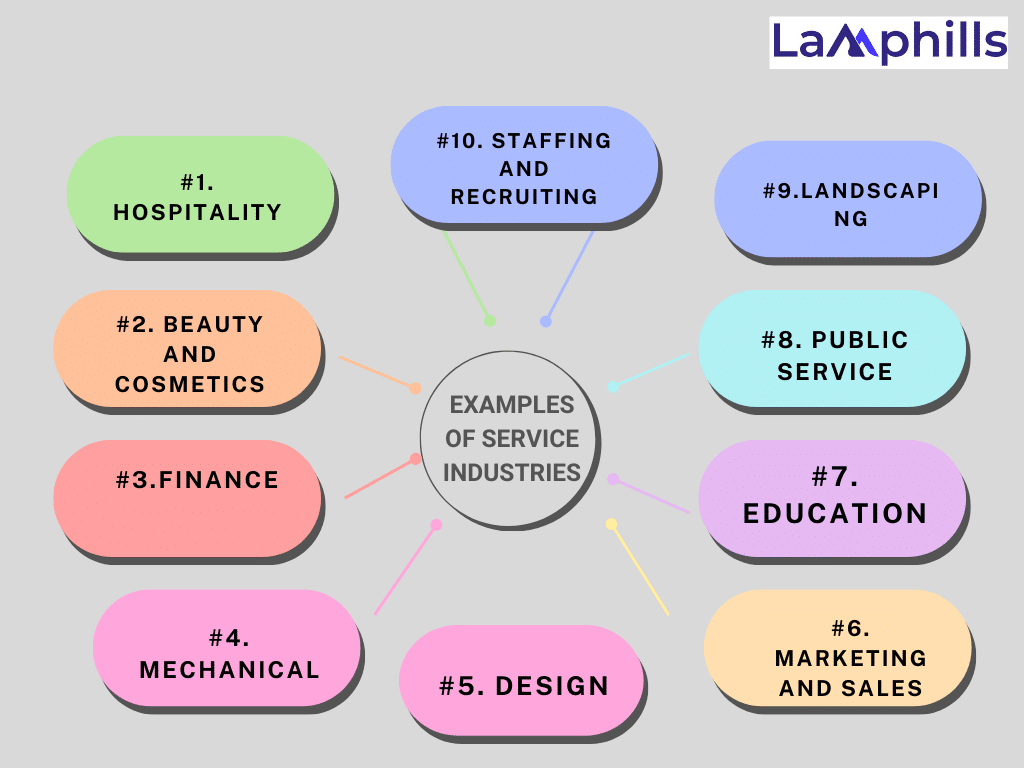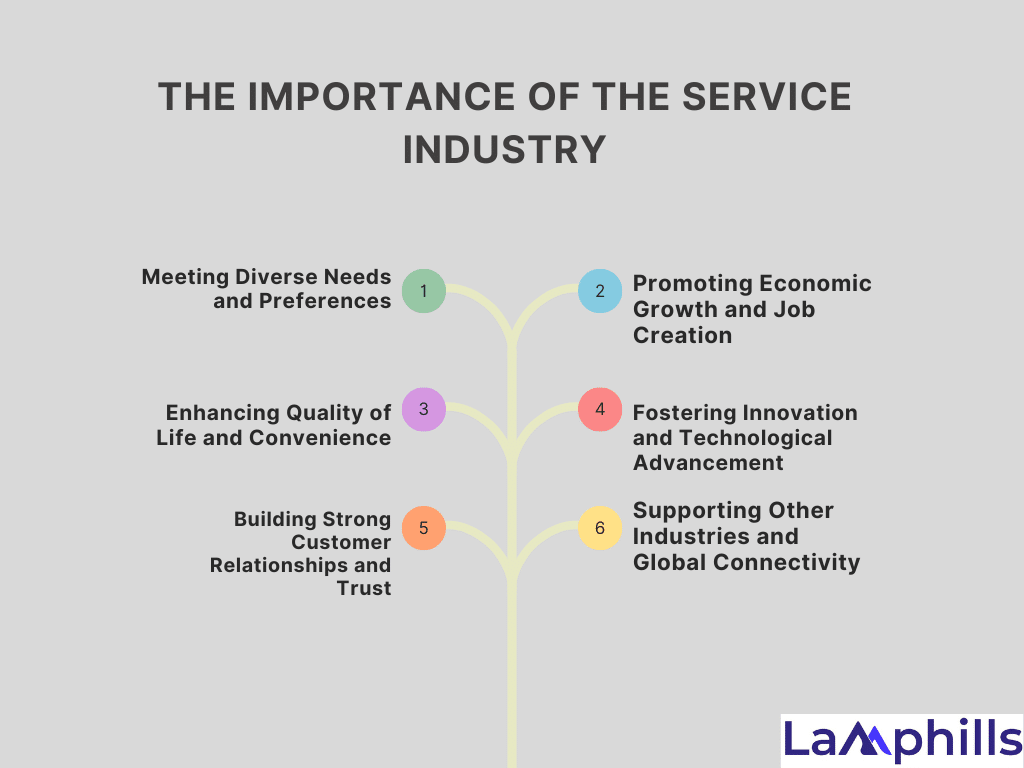Think about this: You walk into your favorite coffee shop. It’s not just the aroma of freshly brewed coffee that entices you, but also the cheerful barista who recalls your name and order. This experience is what keeps you coming back, even though there are dozens of other coffee shops around. This is the magic of excellent service, and it is the foundation of the service industry.
In today’s fast-paced world, when customers have an abundance of options, firms in the service industry must go beyond simply providing a product or service—they must create memorable experiences. As someone who has traversed this terrain for years, I’ve seen firsthand how powerful a well-executed service approach can be. From tech-driven innovations to personalized customer interactions, the path to success in the service industry is multifaceted and ever-evolving.
This article will address the topic, “What is a service industry?” Discuss its significance, as well as the important development and innovation methods that might assist service-oriented organizations in not only surviving but also flourishing in a competitive market. Whether you’re a small business owner, a service manager, or simply interested in the dynamics of the service industry, these insights will help you discover new prospects for success.
Key Takeaways
- Exceptional service isn’t just about fulfilling a transaction—it’s about creating memorable experiences that build customer loyalty. Personalized interactions, like remembering preferences or anticipating needs, can significantly enhance customer satisfaction and retention.
- Innovation is the lifeblood of the service industry. From adapting to digital platforms to introducing new service models, staying ahead of consumer expectations is key. Successful businesses innovate not only in their offerings but also in how they engage with and serve their customers.
- Businesses that prioritize customer relationships—through feedback loops, CRM systems, and personalized service—foster long-term connections that withstand competition. Investing in customer satisfaction pays dividends in reputation and revenue.
- The service industry must be agile. Rapidly changing consumer preferences and technological advancements require businesses to adapt swiftly. By embracing flexibility and staying attuned to market trends, companies can position themselves as industry leaders and drivers of innovation.
What Is a Service Industry?

The service industry sector is an essential component of a functional society and an expanding economy. These businesses hire brilliant people to provide useful services and non-material items. Service industries exist in a variety of sectors, and knowing their position in society can help those interested in a career in service better understand their job opportunities.
A service industry provides individuals with intangible goods or services and performs duties that benefit consumers, clients, businesses, or the broader public. Service industries, unlike manufacturing and production businesses, do not rely on the sale of physical commodities and products to generate profit. Instead, people in the service industry concentrate on accomplishing tasks and providing services. There are several types of nonmaterial goods and products that service industries provide to people, including:
- Customer service
- Consulting
- Management
- Data
- Information
- Safety
- Education
- Maintenance
- Repair
- Cleanliness/sanitation
- Health care
- Knowledge
- Experiences
Understanding the Service Industry Landscape
The service industry is a vast and dynamic sector that affects every part of our lives. From getting a cup of coffee in the morning to having your car serviced or booking a trip, the service industry is critical to meeting our requirements and improving our experiences. Let’s look at what makes this industry special, the trends influencing its development, and the problems and opportunities it brings.
Consider a typical day in your life to gain insight into the service business. Every engagement you have with a business, whether it’s a restaurant, a healthcare provider, or an online customer support chat, falls under the umbrella of the service sector. These connections are frequently brief, but they have a lasting impact. A cheerful greeting from a receptionist or an efficient resolution from a call center can make or break your day.
The landscape of the service industry is constantly evolving, driven by both technological advancements and shifting consumer expectations. In recent years, digital transformation has been at the forefront of these changes. According to a 2023 report by Deloitte, over 80% of service companies have ramped up their investment in digital technologies. This isn’t surprising when you consider how our expectations as consumers have changed—we now expect seamless online experiences, quick responses, and personalized service.
Examples of Service Industries

Below are several examples of service industries, with explanations and common job titles within some categories:
#1. Hospitality
The hospitality industry includes hotels, restaurants and bars. Individuals working in hospitality offer dining experiences, hotel stays, and entertainment to their customers.
Common job titles within the hospitality industry include:
- Server
- Bartender
- Sommelier/wine steward
#2. Beauty and Cosmetics
The beauty and cosmetics industry includes salons, makeup studios, spas, and dermatology clinics. Professionals who work in this industry offer services, such as makeup applications, haircuts, and facials. Here are some common roles you can get in the beauty and cosmetics industry:
- makeup artist
- hairstylist
- esthetician
#3. Finance
The finance industry includes banks, financial consulting firms, and accounting roles. Those working in the finance industry often help clients apply for or set up investments, loans, and bank accounts. They may also offer advice and consultation to customers.
#4. Mechanical
The mechanical industry includes all enterprises that provide repair and maintenance services. Individuals in the mechanical profession offer mechanical knowledge, repairs, and sanitation.
#5. Design
The design industry comprises all organizations and individuals who provide creative and design services to customers and clients. Individuals in this industry offer logo design for businesses, artwork for clients, and home repair and organizing for homeowners.
#6: Marketing and Sales
Marketing and sales specialists provide promotional and sales services to businesses and customers. This type of labor could include selling cars to potential purchasers, running marketing campaigns that efficiently target a company’s target demographic, or listing homes for sale.
#7. Education
Schools, universities, and training facilities are all part of the education industry. Those working in education may provide services such as exam preparation, and general education to help a student acquire a degree and advise on a student’s future educational or career route.
#8: Public Service
The public service sector encompasses all disciplines concerned with public safety and well-being. Individuals who work in public service supply intangible goods, including safety, cleanliness, knowledge, counsel, and customer service.
#9. Landscaping
The landscaping sector consists of enterprises that develop and maintain trees, shrubs, lawns, and gardens. They also build paths, retaining walls, decks, and fences.
#10. Staffing and Recruiting
This includes all staffing agencies and recruiting firms that find suitable positions for candidates. For example, these companies may provide permanent placement, executive search, or temporary placement services.
Strategies for Growth in the Service Industry
Success in the service industry hinges on several key strategies. Here’s how businesses can drive growth and foster innovation:
#1. Customer-Centric Approach
Download This Checklist For Customer Relationship Management (CRM)
Think back to the coffee shop scenario. Personalization is more than just a phrase; it means making each consumer feel valued. According to a Salesforce survey from 2021, 66% of customers expect organizations to understand their specific needs and expectations. To develop deeper connections, service organizations might use data to tailor experiences—for example, by sending personalized offers or remembering consumer preferences.
Trust me, input is invaluable. During my consulting days, we developed a basic feedback loop for a local spa, allowing visitors to review their experience immediately after their visit. This not only gave useful insights into areas for improvement but also demonstrated to customers that their feedback was valued.
In addition to that, CRM systems are the backbone of managing customer interactions and ensuring no detail is overlooked. They help track preferences, purchase histories, and even personal milestones like birthdays, allowing businesses to offer truly personalized service.
#2. Leveraging Technology

Routine chores can be automated, allowing workers to focus on providing outstanding service. AI chatbots, for example, may handle client requests around the clock and respond quickly to typical questions. According to a Gartner estimate, new technologies like AI will account for 70% of customer contacts by 2025.
This is because digital tools are changing how services are delivered. These innovations, which range from online appointment booking systems to mobile ordering apps, help to streamline operations and improve client convenience. I recall a hair salon that doubled its customer base by just introducing an online booking system, which made it easier for customers to make appointments.
Data can also be an effective ally. Businesses can discover trends and insights that help them make better decisions by examining consumer data. For example, a restaurant might use data analytics to identify peak dining times and optimize staffing accordingly, enhancing both efficiency and customer satisfaction.
#3. Employee Engagement and Training

Investing in employee training is crucial. When I worked with a hospitality chain, we introduced a training program focused on enhancing customer interaction skills. The results were remarkable—employees were more confident, and customer satisfaction scores improved significantly.
Empowering employees to make decisions can transform the service experience. For instance, allowing front-line staff to offer discounts or resolve issues on the spot can turn a potentially negative experience into a positive one. A Gallup study found that companies with engaged employees outperform their peers by 147% in earnings per share.
This is because a happy workforce translates into happy customers. Building a positive work culture where employees feel valued and motivated can lead to better service delivery and lower turnover rates.
#4. Innovation in Service Delivery
Agility is about being able to pivot quickly in response to changing market conditions or customer needs. In a rapidly evolving industry, adopting agile practices can help businesses stay ahead. For example, a restaurant that quickly adapts its menu based on seasonal ingredients or customer feedback can keep its offerings fresh and appealing.
Standing out in a crowded market is crucial. This could be through unique service offerings, like a personalized fitness plan at a gym, or through creating an exceptional customer experience, like a hotel that offers a welcome gift personalized to each guest.
Furthermore, collaborating with other businesses can open up new opportunities. A small bakery, for instance, might partner with a local coffee shop to offer exclusive pastry-coffee combos, attracting customers to both establishments.
#5. Sustainability and Social Responsibility
Sustainability is no longer optional. Customers are increasingly drawn to businesses that align with their values. Implementing eco-friendly practices, such as reducing waste or using sustainable materials, can attract a loyal customer base. A Nielsen report found that 73% of global consumers are willing to change their consumption habits to reduce environmental impact.
Engaging with the local community can strengthen a business’s reputation and customer loyalty. This could be through sponsoring local events, participating in community initiatives, or simply supporting local suppliers.
Operating ethically builds trust and can differentiate a business in the eyes of customers. Transparency, fair labor practices, and honest marketing are essential components of an ethical business strategy.
Case Studies and Real-World Examples
Understanding methods for growth and innovation in the service business is critical, but seeing these strategies in action through real-world examples can provide more insight into their efficacy. Let’s look at some case studies that show how firms have successfully adopted these methods to generate success and differentiate themselves in their particular marketplaces.
#1: Zappos – Putting Customer Service First
I once ordered a pair of shoes that arrived with a little flaw. I called customer service, expecting a lengthy return process. To my amazement, the agent not only apologized profusely but also provided a replacement pair overnight at no additional charge. This level of care not only remedied my issue quickly but also gained Zappos a lifetime customer.
Zappos, an online shoe and clothing company, has become synonymous with outstanding customer service. Their dedication to putting their customers first is famous. One of their basic principles is that customer service should not be limited to a single department but rather encompass the entire organization. This attitude is strongly ingrained in their culture, affecting everything from hiring to daily operations.
Key Takeaway: By prioritizing customer satisfaction above all else, Zappos has built a brand known for trust, reliability, and exceptional service. Their approach underscores the importance of investing in customer relationships and going above and beyond to exceed expectations.
#2: Airbnb – Redefining the Hospitality Industry
Airbnb revolutionized the travel and hospitality industries by offering a unique alternative to traditional accommodations. By leveraging technology and embracing the sharing economy, Airbnb transformed how people travel and experience new destinations.
Key Takeaway: Airbnb’s success lies in its ability to connect travelers with unique and authentic experiences. By focusing on personalization and leveraging user-generated content and reviews, Airbnb has created a community-driven platform that fosters trust and encourages repeat bookings.
# 3: Starbucks – Creating a Third-Place Experience
Every time I visit Starbucks, I see how they customize my drink order and remember my preferences. Small gestures, such as writing my name on the cup or offering seasonal promotions, help me feel valued as a client and keep me coming back.
Starbucks has mastered the art of establishing a “third place” experience—a place apart from home and work where people can unwind, interact, and enjoy high-quality coffee. Their success is based on consistent quality, new menu options, and a pleasant environment.
Key Takeaway: Starbucks’ focus on customer experience extends beyond coffee—it’s about creating a sense of community and belonging. By continuously innovating and adapting to customer preferences, Starbucks has established itself as a global leader in the coffeehouse industry.
#4: Amazon – Redefining Convenience and Efficiency
Amazon has reshaped the retail landscape by prioritizing convenience, selection, and speed. Their seamless online shopping experience, coupled with fast and reliable delivery, has set a new standard for customer expectations.
Key Takeaway: Amazon’s relentless focus on innovation and customer-centricity has propelled it to become one of the world’s largest and most influential companies. By leveraging technology, data analytics, and a customer-first approach, Amazon continues to redefine what’s possible in the service industry.
#5: Disney Parks – Creating Magical Experiences
My vacation to Disney World left a lasting impression on me. The seamless combination of characters, themed locations, and customer service made for an outstanding experience. Every staff member, from custodians to performers, contributed to the enchanting environment, resulting in a completely immersive adventure.
Disney Parks are known for providing amazing experiences for people of all ages. From immersive attractions to great customer service, Disney’s devotion to storytelling and attention to detail distinguishes it in the entertainment and hospitality industries.
Key Takeaway: Disney’s success lies in its ability to transport guests into a world of imagination and wonder. By focusing on storytelling, innovation, and creating emotional connections, Disney Parks has maintained its status as a benchmark for excellence in customer experience.
In conclusion, these case studies illustrate the diverse ways businesses in the service industry can innovate and grow by prioritizing customer satisfaction, embracing technology, and fostering a unique brand identity. Whether you’re a small startup or a global corporation, the principles of delivering exceptional service and exceeding customer expectations remain universal. By learning from these examples and applying insights to your business strategy, you can unlock new growth opportunities, build lasting customer relationships, and thrive in today’s competitive marketplace.
The Importance of the Service Industry

The service industry is the backbone of our economy, influencing almost every facet of our everyday lives. From the minute we wake up until we go to bed, we interact with services that improve our quality of life, meet our requirements, and provide critical support. Let’s look at why the service business is so important in today’s environment.
#1. Meeting Diverse Needs and Preferences
Consider how you spend your regular day. You may begin with a cup of coffee from your favorite café, take a ride-sharing app to work, meet with a healthcare professional, and unwind with a streaming service in the evening. Each of these contacts reflects a service that is tailored to satisfy individual needs or preferences.
#2. Promoting Economic Growth and Job Creation
The service industry is a key driver of worldwide economic growth and job creation. In many countries, it accounts for a sizable amount of GDP and employs millions of people in a variety of industries, including hospitality, retail, healthcare, and finance. Service firms not only provide jobs, but they also help to strengthen local economies through taxes and investments.
#3. Enhancing Quality of Life and Convenience
Recently, during a hectic work week, I depended extensively on food delivery services to guarantee I had nutritional meals without having to go grocery shopping or cook. The ease of ordering meals online, following delivery status, and receiving them at my door helped me to concentrate on my work and maintain a healthy lifestyle.
Services improve our quality of life by making jobs simpler, easier, and accessible. Services streamline operations and save crucial time, whether it’s shopping for groceries online, getting medical advice from telehealth, or reserving travel lodgings with a few taps on a smartphone.
#4. Fostering Innovation and Technological Advancement
Think of the evolution of bank services. What began as typical brick-and-mortar branches has developed into mobile banking apps that provide 24-hour access to account information, remote check deposits, and personalized financial advice. These innovations not only increase consumer happiness but also improve operational efficiency for financial organizations.
The service business is a hub of innovation, continuously pushing the limits of technology and the consumer experience. From AI-powered chatbots that give fast customer help to personalized suggestions based on data analytics, technological breakthroughs in services are redefining how organizations interact with customers and create value.
#5. Building Strong Customer Relationships and Trust
In the service industry, building trust and fostering strong customer relationships are paramount. Whether it’s a local hair salon that remembers your haircut preferences or an online retailer that offers hassle-free returns, businesses that prioritize customer satisfaction and loyalty thrive in competitive markets.
#6. Supporting Other Industries and Global Connectivity
Services play an important role in assisting other industries and facilitating international connectivity. Logistics services, for example, guarantee that items reach consumers expediently and securely, while IT services enable firms to interact effectively across borders using digital platforms and communication tools.
Furthermore, the service business is about more than just transactions; it is about improving people’s lives, encouraging innovation, and establishing relationships across communities and countries. As technology advances and consumer expectations change, firms in the service sector must adapt and innovate to meet new challenges and possibilities.
Hence, understanding the critical role of services in our economy and everyday lives allows us to recognize their importance and aspire to improve the experiences they provide. Whether you’re a service provider, a consumer, or simply interested in the dynamics of the service industry, recognizing its importance is key to navigating the evolving landscape of modern business and society.
What is an example of a service industry?
A list of service industries can include everything from finance to retail to electronics and software to medicine, nonprofits, and beyond.
What are the three types of services?
When speaking of the service industry, is usually broken down into three categories. They are consumer services, business services, and public services.
Is Apple a service industry?
Yes, Apple now generates more revenue from services than any other product category except the iPhone. This
Conclusion
Finally, the service industry has a significant impact on our economy, improving our daily lives and building important connections between businesses and customers. Whether you’re a service provider looking to innovate and surpass customer expectations or a consumer looking for convenience and tailored experiences, understanding the dynamics of this dynamic sector is critical to navigating its intricacies and realizing its full potential.
As we embark on this journey of continual learning and adaptation, let us embrace the four values of service excellence: integrity, empathy, creativity, and collaboration. We can ensure that the service business thrives and evolves in the coming years by remaining on top of market trends, embracing technology improvements, and placing customers at the center of our strategy.






